| Abstract |
Samantha Olschan, Greenhouse Studios, and University of Connecticut Background The University of Connecticut’s Digital Media & Design Department (DMD), in collaboration with the University Libraries and University of Connecticut Humanities Institute (UCHI), have launched the Greenhouse Studios / Scholarly Communications Design at the University of Connecticut (http://greenhousestudios.uconn.edu/). With funding from the Andrew W. Mellon Foundation, and backed by long-term University investments of staff and space, Greenhouse Studios will implement a design-based, inquiry-driven, collaboration-first workflow that will address the divided workflows and counter-productive labor arrangements that have complicated scholarly communications in the digital age. Even as the scholarly communications field pursues the opportunities presented by digital technology, its routine operations remain anchored in print-centric regimens. For those working to evolve scholarly communications in the Internet age, particularly as it bears upon long-form scholarship, there is compelling need to productively disrupt and reconfigure the workflows and work cultures that have naturalized around the production of printed products. Taking inspiration from Design Thinking (and its critics) – artists, designers and developers are brought in at the early stages of scholarly research to provide artistic design, creative expression, and technical implementation assistance for project iterations and development. Objective The paper will address how designers are finding roles, and perhaps more importantly, asserting the value of design in collaborative research and interdisciplinary projects related to digital scholarship via Greenhouse Studios at the University of Connecticut. By observing the established working process model, current projects and pipelines, and the branding process of the Greenhouse Studios we seek to answer the questions: How can we better articulate the scholarly merit of collaboration? How can collaborative design scholarship and projects be positioned within the tenure and promotion process in the field of design to positive outcome? What are the forms these scholarly activities might take? How might these scholarly practices affect design education? Methods The paper will outline the development of the cross-disciplinary process model, projects, and the branding process for Greenhouse Studios / Scholarly Communications Design at the University of Connecticut. Through this development and implementation the studio illustrates how incorporating the designer, implementing design thinking, and adopting an evolutionary approach to identity and information design at the early stages of scholarly projects, impacts the value of design in research and interdisciplinary collaboration.
In defining and documenting our evolving process/practice, we began to observe how early integration of the designer in scholarly practices and communication affect and illuminate project outcomes, our reflections on the building and design process, as well as opportunities for design education. Throughout the development we documented our process and practice in a variety of ways, through still photographic imagery, moving image and time-based media, iterative visual communication and graphic design, animation and motion graphics. This practice allowed for the team to derive creative content for further communication, marketing, illustration and production but also reflect on their practice and process. We identified the best visual communication style for the project, process charts and generated an open-source, hand-rendered typeface with students and interns, based on handwriting, (the “artists hand”) to pay homage to traditional practices, research and publishing methodologies while referencing emerging technology and media through digitization. 
Samantha Olschan is a transmedia artist & designer with a M.F.A. in Film, Video & New Media: Animation from The School of the Art Institute of Chicago & a B.F.A in Fine Arts: Electronic & Time-Based Media from Carnegie Mellon University. Having worked across broadcast design, animation, compositing and time-based visualization for television, films, documentaries and media agencies, she continues to research hybrid media & storytelling through animation, design & experiential narrative. Recent exhibitions and screenings include the Black Maria Film & Video Festival, FrackFest, P.O.V. Series (PBS), The ShortList (PBS), Visionfest, Tribeca Cinemas, Bumbershoot, Seattle International Film Festival, Boston Cinema Census, Boston Underground Film Festival, Conversations at the Edge, The Gene Siskel Film Center, Marblehead Film Festival & the Skopelos Foundation for the Arts in Greece. Teaching appointments in animation, media and design include University of Connecticut, Pratt Institute, Wesleyan University, Quinnipiac University, Columbia College, New York Film Academy & The School of the Art Institute of Chicago. She is currently an Assistant Professor in the Digital Media & Design Department (dmd.uconn.edu) at the University of Connecticut. This was a Long Paper Session: Student-led Labs on June 3, 2017. 9:00–10:30am (SCI 106) |
|---|---|
| Format | |
| Publication Date |
2017-06-03
|
| Keywords | |
| Rights |
http://rightsstatements.org/vocab/InC/1.0/
|
| Community | |
| Permalink | https://oaks.kent.edu/converge/greenhouse-studios-scholarly-communications-design-university-connecticut |
Greenhouse Studios / Scholarly Communications Design at the University of Connecticut
Greenhouse Studios / Scholarly Communications Design at the University of Connecticut (1–). (2017). (1–). https://oaks.kent.edu/node/17035
“Greenhouse Studios Scholarly Communications Design at the University of Connecticut”. 2017. https://oaks.kent.edu/node/17035.
Greenhouse Studios Scholarly Communications Design at the University of Connecticut. 3 June 2017, https://oaks.kent.edu/node/17035.


